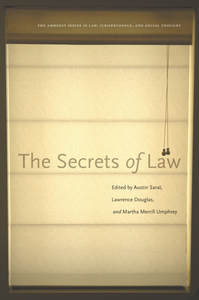 by Austin Sarat, Lawrence Douglas and Martha Merrill Umphrey eds. Stanford, CA: Stanford University Press 2012, 288 pages. Cloth $65.00 ISBN: 9780804782593.
by Austin Sarat, Lawrence Douglas and Martha Merrill Umphrey eds. Stanford, CA: Stanford University Press 2012, 288 pages. Cloth $65.00 ISBN: 9780804782593.Reviewed by Kevin M. Wagner, Department of Political Science, Florida Atlantic University
pp.100-101
While the title might suggest otherwise, "The Secrets of Law" is not a primer on hidden areas of law or esoteric understandings of legal systems or legal process. This book is an ambitious effort to bring together a series of six essays related to the application of legal principles related primarily to transparency and openness. It is an exploration of how and why democratic states balance the need for openness with the functional needs of the state.
The opening chapter of the book frames the discussion and following essays. Sarat, Umphrey, and Douglas review the concept of secrecy and governance seen through the example of the website WikiLeaks.org. The use of that particular scandal is clever construction as it grounds what could be a somewhat undefined conceptual argument into a very real world controversy. The editors illustrate that state secrecy is a strikingly important issue today and will continue to be so for some time.
Creating books from a conference or a seminar series can be challenging. The usual result is a mixed bag of strong contributions and lesser ones. This book is no different. After the introductory chapter, the book is divided into a series of single authored chapters which link to the issue of secrecy with mixed success. While the essays are, for the most part, thoughtful and interesting, the topics are so wide ranging that the links between them are hard to see in anything but the most abstract of views.
While the idea of secrecy and its limitation in a state is more than appropriate for a book, the focus can get blurred. Secrecy is not the same in the context of war related national security as it would be in a straightforward civil legal proceeding. Grouping them together in the same thematic tapestry seems a stretch at best. Discussing both challenges the ability of the book to be entirely coherent.
Nonetheless, there is a great deal to like about this book. If you can accept that the only consistent commonality is a discussion related to state secrecy, the book has much to offer. The contributors effectively construct and explain the nature of the value conflict between secrecy and governance. They raise important questions about the need for both openness and secrecy in a democratic state.
Alasdair Robert's "open Secrets and Dirty Hands" is an excellent look back at the secrecy conflict during the Bush Administration and he effectively presents the idea of a willing ignorance as a complicit element of perceived government secrecy. In Robert's essay, secrecy is a result of a tacit society and state arrangement.[*101]
Alternatively, Lindsay Farmer's essay is a legal historical review of the development of the English trial system and shows the inherent value conflict between public openness and public justice. The historical analytical approach is effective in both argument and framing.
Edward Stein's "Spousal Secrets: Same-Sex Couples and the Functional Approach to Marital Evidentiary Privileges" is a considered review of spousal privilege with a prescription for addressing the needs of same sex couples under modern law. While an ably written essay, it is so different from the preceding essays in approach and context that it seems like it should be in a different book.
The final three essays in the book are related in that they grapple with the idea of what transparency means in law and society. But, as was true in the first chapters, the topics are far ranging and distant from each other. Bernadette Meyler examines public disclosures though literary history. Melanie Williams focuses her review of secrecy on labor law. Richard Burt “put[s] deconstructive pressure on the positivist and historicist assumptions of the rule of law and secrecy in general” by analyzing legal secrets in the cinema, to show that positivist and historicist assumptions about secrecy and the law are, in practice, not met (p.213). All of the chapters have interesting, if sometimes tangential relations to the overall premise.
The book should have appeal to political theorists in the area of law and society. This is a good book for a broad overview of the subject, as a result, I would recommend this book as a supplement to graduate and upper division jurisprudence or law and society classes as a means to engage students on the meaning of law and its role in society. Overall, it is a worthwhile if a bit disjointed effort.
Copyright 2014 by the Author, Kevin M. Wagner.